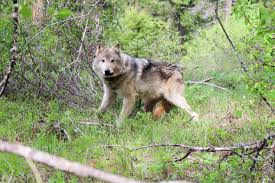Three New Animal Packs Confirmed; CPW Looks to Take Stronger Lethal Action
Trevor Phipps
The ongoing “killer” wolf controversy has refused to die with residents living near the cities in Colorado’s Front Range bracing for the worst as the wild animals were even tracked close to the Denver metro area last spring.
Then, in the early summer season and more recently, the wolves were on the move again and getting closer to Teller County as they were spotted roaming through neighboring counties. This trend has continued at a possible dangerous level, according to landowners.
During the latest map issued by Colorado Parks and Wildlife (CPW) at the end of July, most of the wolves threatening the Front Range and the Denver Metro had moved further north and west. However, the newest map did show that at least one wolf was still wandering around Park County, at the doorstep of Teller.
This has raised the ire of property owners and ranchers, based on the track record of the released wild wolves, who have slaughtered cattle and much livestock already throughout Colorado and grown in numbers since the state started its wolf reintroduction program in 2023. Unfortunately, landowners can’t fight back, unless they are physically attacked, based on their wolves’ designation as an endangered species
The wild wolf scenario stems from a ballot issue narrowly approved by Colorado voters, calling for the implementation of a wolf release program. The issue, though, was heavily opposed in rural areas, where the wolves were slated to be released. The entire wolf controversy has heightened tensions between rural and city lawmakers across the state.
According to the latest map that reported on wolf activity between June 24 and July 22, wolves have been tracked in Park County watersheds near the towns of Fairplay and Hartsel, less than 30 miles from the county’s border with Teller County. Wolves were also tracked in southern Chaffee County near Salida and the border of Chaffee and Fremont (Teller’s neighbor to the south) Counties.
This marks at least the third time since wolves were reintroduced that they have come close to crossing the border into Teller. Last February, authorities reported that a sole female wolf did make it into the western part of the county.
Officials alerted local authorities and major landowners that a wolf was in the region. But then, the next map showed that the wolf had moved further west and had traveled hundreds of miles possibly looking for a mate
Since then, Teller County residents have been put on high alert, with tempers sometimes igniting at county commissioner meetings over the situation. But over the last few months, CPW has worked hard to educate ranchers and other landowners about the steps they can take to protect livestock from wolves. And even though Teller County hasn’t had to deal with any wolf attacks yet, it could be only a matter of time when property owners face this reality.
In other parts of the state, range riders and other methods have been deployed to keep wolves away from livestock. However, despite several actions taken by ranchers and CPW, wolf depredations on livestock keep happening. And the bad news is, most of the attacks have been linked to one wolf pack, which was already previously relocated due to chronic depredations of livestock.
Officials Look To Lethally Remove Another Killer Wolf
Colorado’s Copper Creek wolf pack was the first pack officially formed in Colorado after adult wolves were relocated to Grand and Summit Counties from Washington and Oregon at the end of 2023. But as soon as the pack formed near Williams’ Fork Reservoir southeast of Kremmling in Grand County, it started getting blamed for assaulting livestock. And to make matters worse, some ranchers determined that the matriarch and patriarch of the pack had a history of depredating livestock before they were relocated to the state, which is something CPW said they would not do.
After several livestock depredations in Grand County related to the Copper Creek pack, CPW captured the entire pack besides one wolf pup that they couldn’t catch. Shortly after they captured the pack, the patriarch wolf of the pack died from injuries sustained from a gunshot wound.
But instead of keeping the pack in a shelter, CPW made the decision to re-release the pack in Pitkin County with another group of wolves relocated to the state from Canada at the end of 2024. Shortly after, CPW announced that the matriarch of the pack had reproduced again with a new wolf from Canada and the pack had grown.
But then livestock attacks kept happening. After several depredations, CPW made the decision to lethally remove one male yearling. CPW officials said that they tracked the depredations to a single wolf and that its removal should correct the pack’s behavior.
But evidently it didn’t. Ranchers have claimed that the Copper Creek pack has continued to be the cause of livestock loss.
In late July, CPW announced that it was attempting to locate the Copper Creek Pack so that it could lethally remove another member of the pack. But at press time, CPW officials still had not found the pack due to the wolves being located in challenging terrain.
Also last month, CPW announced that three more packs have formed across the state. Colorado now has the One Ear Pack of Jackson County, the King Mountain Pack of Routt County, and the Three Creeks Pack of Rio Blanco County. Authorities are not yet sure how many new wolves have been born to the packs.
PBS Film Highlights Local Wolf and Wildlife Center Director
Ever since the talk of bringing back wolves to Colorado started around 2016, Darlene Kobobel, the director of the Colorado Wolf and Wildlife Center (located in Divide) has been a strong advocate for bringing wolves back in order to help the state’s ecosystem. Kobobel was even on the scene in 2023 when CPW officials released the first group of relocated wolves from Oregon.




